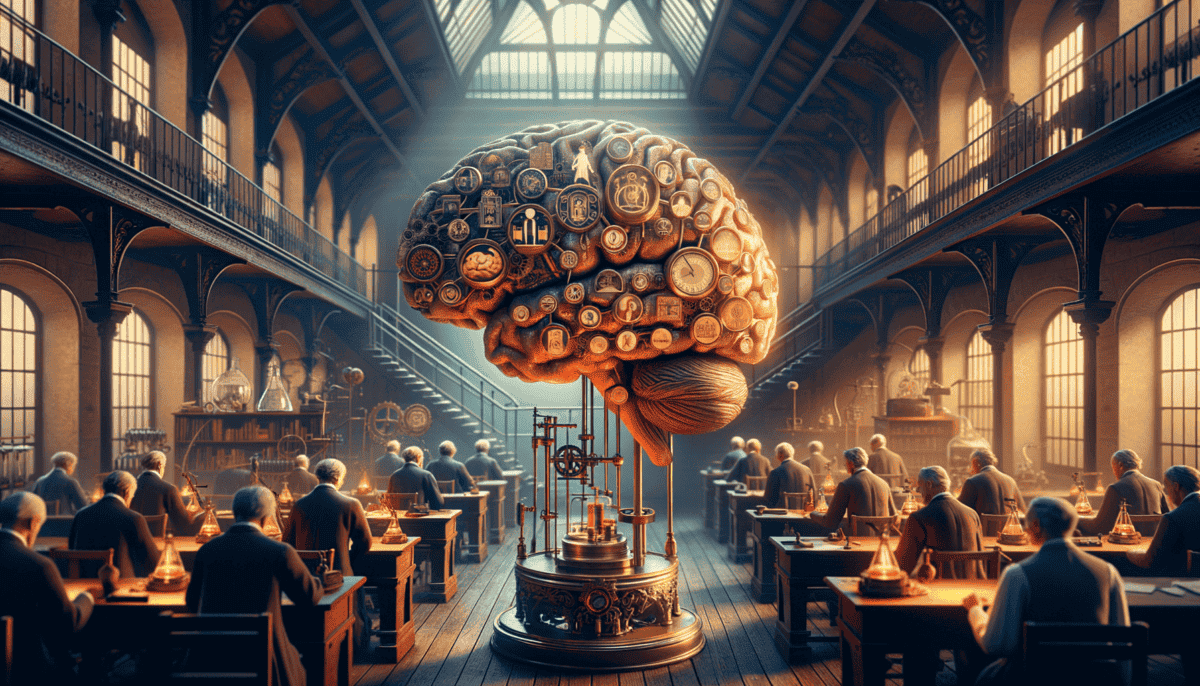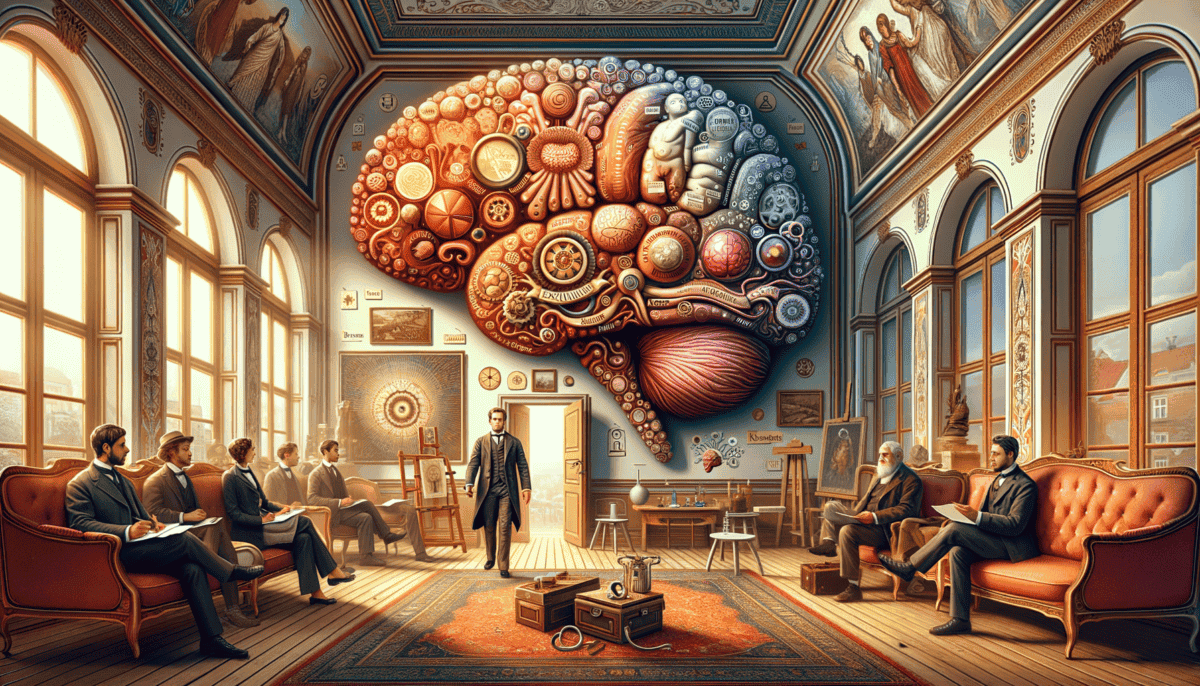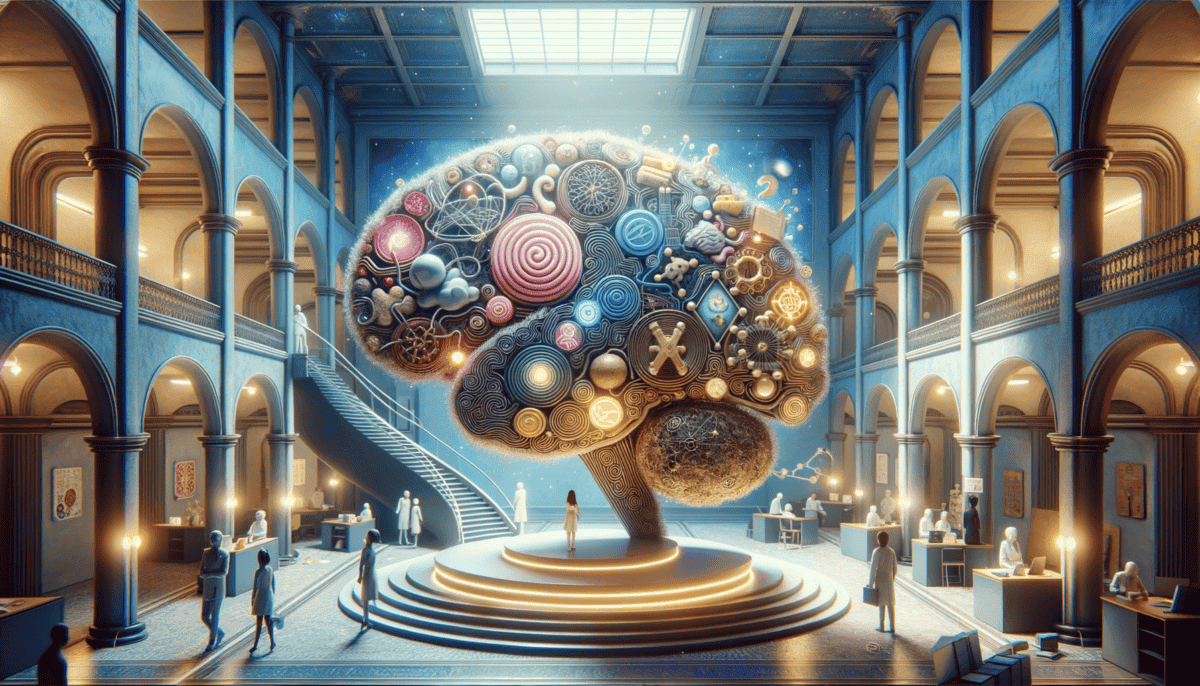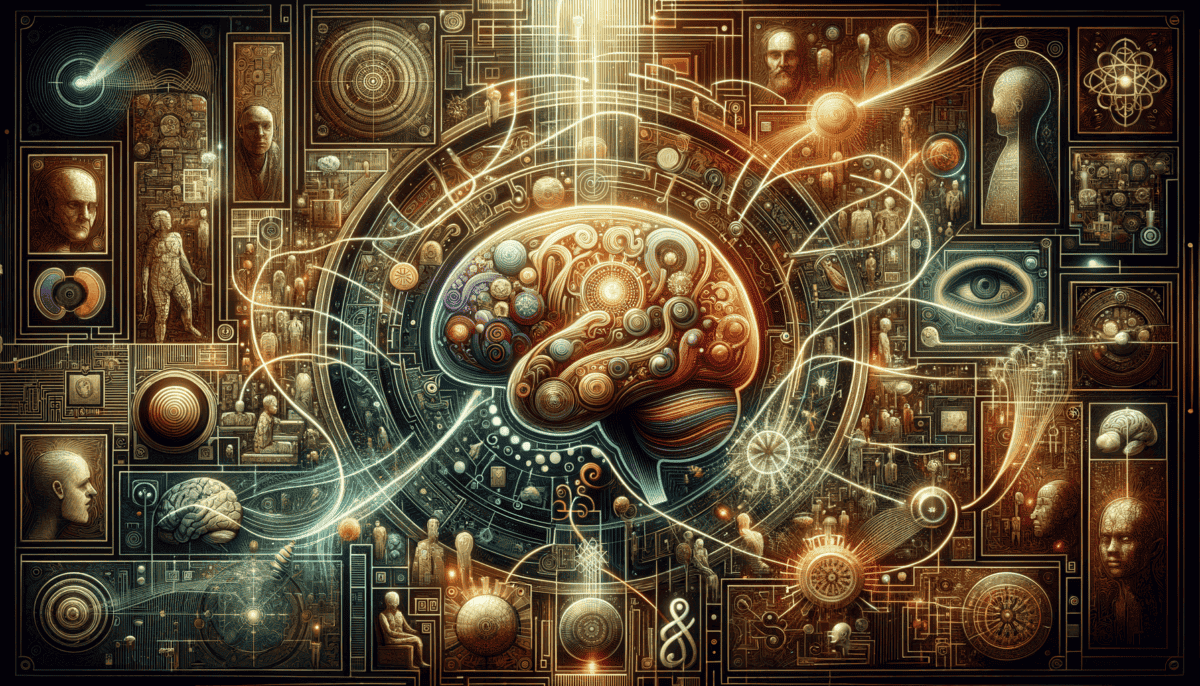The Ancient Whispers of the Mind
The warm Mediterranean sun shone down on young Theron as he walked through the bustling streets of Athens. His sandals clicked against the stone path while he made his way to the great academy where the wise teachers shared their knowledge.
"What makes us think and feel the way we do?" Theron wondered, watching the people around him. Some laughed, others argued, and a few sat quietly lost in thought.
The marketplace was alive with activity. A merchant shouted about his fresh olives while two friends debated loudly about politics. Theron noticed how their faces changed with each emotion – happiness, anger, confusion. It was like watching a play where the actors kept changing masks.
At the academy, Theron found his teacher Aristotle speaking to a group of students under an olive tree. The wise man's eyes twinkled as he asked, "Why do we remember some things but forget others?"
A cool breeze rustled through the leaves as the students thought about this question. Theron raised his hand. "Maybe our minds are like wax tablets," he suggested. "Some marks stay deep while others fade away."
Aristotle smiled. "An interesting thought! Just as we exercise our bodies in the gymnasium, perhaps we must exercise our minds to keep them strong."
“The mind is like a garden,” Aristotle explained. “We must tend to our thoughts carefully, just as a gardener tends to their plants.”
Later that day, Theron sat by the fountain in the courtyard, watching water splash and sparkle in the sunlight. A fellow student named Helena joined him.
"What troubles you, Theron?" she asked, noticing his thoughtful expression.
"I'm trying to understand why people act differently when they're happy or sad," he replied. "Sometimes I feel joy bubble up inside me like this fountain, but other times my thoughts are as still as a quiet pool."
Helena nodded. "And have you noticed how one person's feelings can spread to others? Like when someone starts laughing, soon everyone is laughing too!"
As the sun began to set, casting long shadows across the marble columns, Theron thought about everything he had learned. People were like puzzles with many pieces – their thoughts, feelings, and actions all connected in mysterious ways.
That night, as he walked home under the starlit sky, Theron realized that understanding the human mind was like trying to count all the stars above. There was so much to learn, and every answer seemed to lead to more questions. ⭐
But that's what made it exciting! Just as explorers set sail to discover new lands, Theron knew he was at the beginning of an amazing journey to understand the greatest mystery of all – how our minds work.
He couldn't wait to learn more tomorrow. After all, as his teacher often said, "The more we learn about our minds, the better we understand ourselves and each other."
The evening air grew cool as Theron reached his home. Tomorrow would bring new questions and new discoveries. The journey to understand the human mind had only just begun, and there were still so many mysteries waiting to be solved.
The Dawn of Scientific Discovery
The year was 1879, and the streets of Leipzig, Germany, buzzed with excitement. A young student named Marie hurried through the cobblestone streets, her boots clicking against the stones. She was headed to a very special place – the world’s first psychology laboratory! ️
“Today’s the day!” Marie whispered to herself, clutching her notebook tightly. She was going to help Dr. Wilhelm Wundt with his amazing experiments about how people think.
The laboratory was different from other places Marie had seen. It had shiny instruments and quiet rooms where people could focus on their thoughts. Dr. Wundt greeted her with a warm smile.
“Welcome, Marie! Are you ready to be a science detective?” he asked, his eyes twinkling behind round glasses. “Today we’re going to study how fast people can think!”
“Our minds are like busy cities,” Dr. Wundt explained. “We want to understand all the activity happening inside!”
The experiment was simple but clever. People would hear a sound and press a button as quickly as they could. Marie helped measure how long it took them to react.
“Look!” she exclaimed. “Everyone takes a different amount of time to press the button. Why is that, Dr. Wundt?”
“That’s exactly the kind of question a good scientist asks,” he replied. “Our minds work in different ways, just like people walk at different speeds.”
Later that day, Marie watched as more experiments took place. Some people looked at different colors and described how they felt. Others tried to remember lists of words.
“It’s like we’re building a map of the mind,” Marie said to her friend Thomas, another student helper. “Each experiment shows us a new path!”
Thomas nodded eagerly. “And the best part is, we’re using real science to understand things people only guessed about before!”
Dr. Wundt gathered everyone at the end of the day. “Remember,” he said, “we’re like explorers charting new territory. Every discovery helps us understand people better.”
As Marie walked home that evening, she noticed how the street lamps were being lit one by one. It reminded her of how each experiment was like lighting up a new part of understanding the human mind.
“There’s so much more to learn,” she thought excitedly. The scientific study of psychology was just beginning, and Marie couldn’t wait to see what new discoveries tomorrow would bring. ⭐
The cool evening air carried the sounds of the city – people talking, horses trotting, distant music. Each sound made Marie think about how amazing it was that their minds could understand so many things at once.
She reached home and carefully wrote in her diary about everything she had learned. This was just the start of an exciting new way to study how people think and feel. The age of scientific psychology had begun, and there were so many mysteries yet to solve!
Inside the Hidden Mind
The streets of Vienna sparkled with morning frost as Dr. Anna Meyer hurried toward a tall building. The year was 1900, and she was going to meet someone very special – Dr. Sigmund Freud!
“Dreams are like secret messages from our minds,” Dr. Freud said as Anna sat down in his warm office. Pictures covered the walls, and a comfy couch sat in the corner.
“Tell me about your dream from last night,” Dr. Freud asked a patient named Sophie. She sat on the famous couch, thinking hard.
“I dreamed I was chasing a butterfly,” Sophie said. “But I couldn’t catch it, no matter how fast I ran.”
Dr. Freud smiled kindly. “Sometimes our dreams show us what we want in real life. What are you trying to catch in your life, Sophie?”
“Our minds are like treasure boxes,” Dr. Freud explained. “They hold secrets we don’t even know about!”
Anna watched as more people came to talk about their feelings and dreams. Some were happy, some were scared, and some didn’t know why they felt the way they did.
“It’s like our minds have different rooms,” Dr. Freud told Anna. “Some rooms are easy to see into, but others are locked up tight.”
Later that day, a young man named Marcus visited. He was afraid of horses but didn’t know why. Dr. Freud helped him remember a scary experience with a horse when he was little.
“Aha!” Marcus exclaimed. “That’s why I get nervous around horses! I forgot all about that day!”
Anna wrote everything down in her notebook. She was amazed at how talking about feelings could help people feel better.
“Sometimes,” Dr. Freud said, “our minds hide scary or sad memories to protect us. But those hidden memories can still affect how we feel.”
As the day grew darker, candles were lit in the office. Their warm light made shadows dance on the walls. It reminded Anna of how thoughts could hide in the shadows of our minds. ️
“We all have wishes and fears we don’t know about,” Dr. Freud explained to his students. “Understanding these hidden feelings helps us grow stronger.”
Walking home that evening, Anna thought about all the amazing things she had learned. Every person’s mind was like a story waiting to be told. Some stories were happy, some were sad, but all were important.
The stars twinkled above as Anna wrote in her diary. She drew a picture of an iceberg to remember Dr. Freud’s special idea. Tomorrow would bring new stories and new understanding about the mysterious hidden parts of our minds! ⭐
The Power of Learning
The sun rose over a busy college campus in 1950. Dr. Sarah Thompson watched students hurry to class. She smiled, thinking about the exciting experiments waiting in her lab.
“Today, we’re going to learn how people learn!” she told her student helper, Tommy. Her eyes sparkled with excitement.
In her special lab room, Dr. Thompson had built a maze for her pet mouse, Whiskers. “Watch this,” she said to Tommy.
Whiskers scurried through the maze. When he found the cheese at the end, a tiny bell rang. After a few tries, Whiskers ran straight to the cheese!
“See?” Dr. Thompson said. “Whiskers learned that the bell means cheese. This is called conditioning!”
“Everything we do has a result. Good results make us want to do things again!” Dr. Thompson explained.
Next door, Dr. B.F. Skinner was doing his own experiments. He had a special box with a button. When birds pecked the button, they got food!
“Look how fast they learn!” Tommy said, watching the birds peck away.
Later that day, a little girl named Lucy came to visit the lab. She was afraid of dogs after seeing a scary movie.
“We can help you be brave,” Dr. Thompson said kindly. Every day, Lucy would look at pictures of friendly puppies while eating ice cream.
Soon, Lucy wasn’t scared anymore! “The ice cream helped me see that dogs can be nice!” she said happily.
“Our actions are like building blocks,” Dr. Thompson told her students. “Each good choice helps us build better habits!” ️
Tommy watched as more people came to learn about behavior. Some wanted to stop biting their nails. Others wanted to study better.
“Small steps lead to big changes,” Dr. Thompson said. She helped people make charts to track their progress.
As the afternoon sun filled the lab, Dr. Thompson wrote in her research book. She drew pictures of happy faces to show how people felt better after learning new things.
“Everyone can learn and change,” she told Tommy. “We just need to understand how our choices affect us.”
The campus bells rang as students headed home. Dr. Thompson looked at all the experiments happening in her lab. Tomorrow would bring new discoveries about how people learn and grow!
Minds Growing and Glowing
The world changed a lot in the 1960s. People wanted to know more about how our brains think and grow. Dr. Maria Chen sat in her bright office, looking at pictures of children playing.
“Our minds are like gardens,” she told her student Anna. “They need care to grow strong.” Dr. Chen loved watching how people’s minds changed as they learned new things.
In Switzerland, a wise man named Jean Piaget watched children solve puzzles. He saw that kids think differently at different ages.
“Look at little Marco,” Dr. Chen said, pointing to a video. “At age 4, he thinks the tall glass has more juice just because it’s tall. By age 7, he understands both glasses have the same amount!”
Anna watched as children of different ages played with blocks and drew pictures. Some made simple towers, while others built entire cities! ️
Dr. Chen had a special computer that could take pictures of brains while people thought about things. “See how it lights up when Jimmy solves math problems?” she showed Anna. “That’s his brain working hard!”
In her lab, Dr. Chen helped people understand memory too. “Close your eyes,” she told a group of students. “Picture your favorite birthday cake. Your mind can see it, even though it’s not here!”
Scientists around the world shared their discoveries. They learned that feelings are just as important as thoughts. Some people were better at understanding feelings than others.
“Remember when you first learned to ride a bike?” Dr. Chen asked Anna. “At first, your brain had to think about every little move. Now you just hop on and go!”
Dr. Chen wrote books to help teachers understand how children learn. She showed that playing and making mistakes helps brains grow stronger.
“When we understand how minds work,” she said, “we can help everyone learn better!”
As the sun set, Dr. Chen looked at all the colorful brain pictures on her wall. Every one told a story of someone learning and growing.
Outside her window, children played on swings, their minds full of dreams and questions. Tomorrow would bring new chances to understand the amazing power of our thinking minds! ⭐
Future Minds, Future Dreams
The morning sun peeked through the window of Dr. Chen’s high-tech lab. Colorful screens lit up the walls, showing bright pictures of thinking brains. Today was special – her student Anna was ready to share their amazing findings!
“Look at this!” Anna pointed excitedly. “When we play video games, our brains light up like fireworks! And when we hug someone we love, different parts glow warm and bright!”
Dr. Chen smiled proudly. They had learned so much about how minds work. Now they had cool new tools to see inside brains while people think, feel, and learn.
“Remember when people thought the brain was like a computer?” Anna laughed. “Now we know it’s more like a garden – always growing new connections!”
Dr. Chen showed Anna their newest invention – special glasses that could help people understand others’ feelings better. When someone wore them, they could see tiny clues in faces that showed how others felt.
“These will help people who have trouble reading emotions,” Dr. Chen explained. “Technology and understanding minds working together!”
In another part of the lab, people learned to control computers with just their thoughts. “This will help people who can’t move their bodies,” Anna said. “Their minds can still do amazing things!”
Dr. Chen shared their discoveries with the world through a special screen. Scientists from everywhere joined in, sharing their own exciting finds about minds and brains.
The Mind’s Amazing Powers
They learned that:
- Dreams help our brains solve problems while we sleep
- Learning new things makes our brains stronger at any age
- Being kind to ourselves helps our minds stay healthy ❤️
- Everyone’s brain is special and unique, like a fingerprint ️
- Working together makes all our minds better
As the day ended, Dr. Chen and Anna looked out at the city lights. “What we’ve learned about minds has changed everything,” Dr. Chen said. “But the most exciting discoveries are still ahead!”
Anna nodded, her eyes bright with dreams. “And the best part is, our minds will keep growing stronger as we learn more!”
Outside, children played under the stars, their minds full of wonderful new ideas. The story of understanding our amazing brains would keep growing, just like the minds that studied them. Together, they would discover even more amazing things about the power of thinking, feeling, and dreaming. ⭐
As the stars twinkled above, Dr. Chen knew that every mind held endless possibilities. The adventure of understanding our thoughts and feelings would never end – it would only get more exciting with each new day!






